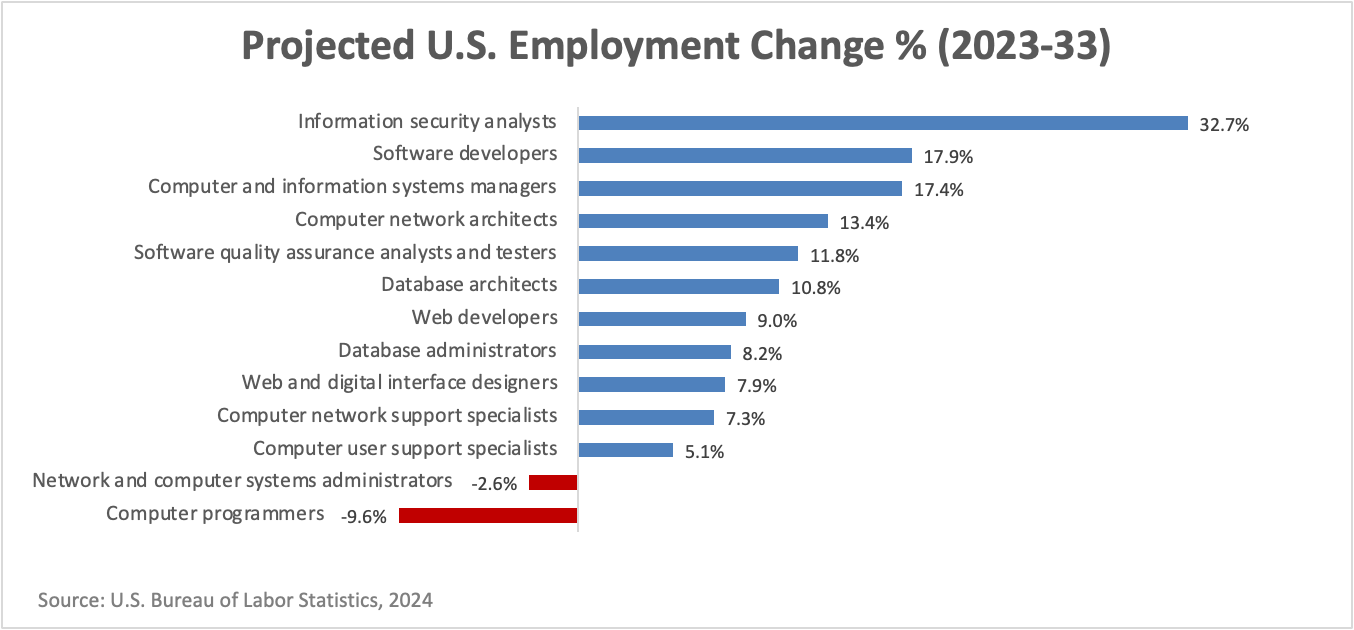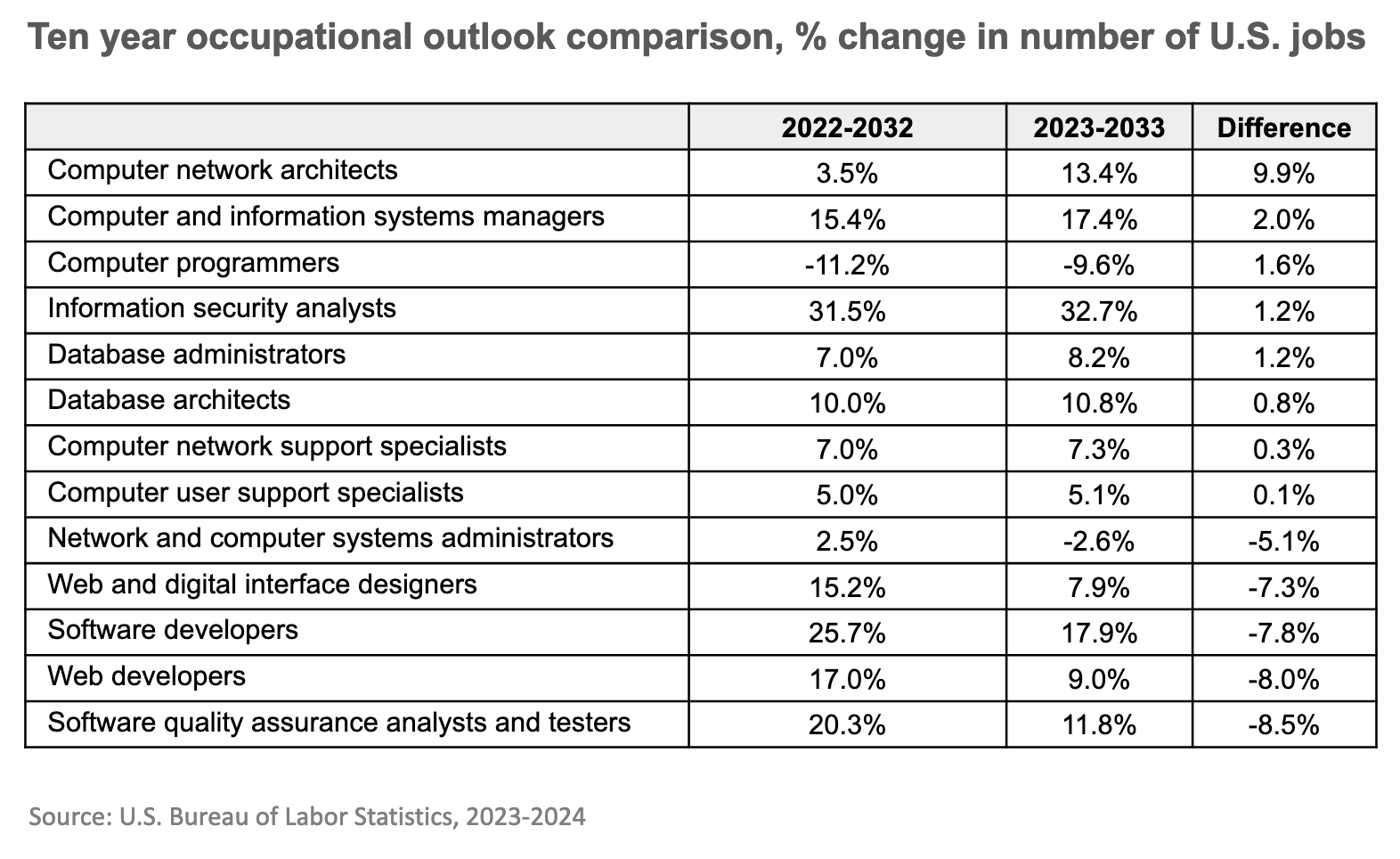Ten Year IT Job Outlook: Positive News for Cybersecurity, Software Development, and Management Roles
The US Bureau of Labor Statistics (BLS) projects 4% job growth for all jobs, but the outlook for IT jobs is much better. Peter Tsai breaks down the prospects for various information technology occupations between 2023-2033.
Forward-looking employment data helps job seekers understand what companies are hiring for now and which careers will be in demand in the future.
Every year, the US Bureau of Labor Statistics (BLS) publishes ten-year employment projections for all occupations in the United States. The agency recently released its updated forecast for the time period between 2023 and 2033.
IT job outlook for the next 10 years
In our previous article on the long-term future of IT jobs, we reported that the BLS predicted overall job growth (for all occupations) of 3% for the ten-year period between 2022-2032 and the addition of approximately 4.7M jobs. In their new 2023-2033 data, the agency projects 4% job growth with an expected increase of 6.7M jobs.
While this more positive outlook is encouraging news, the aggregate numbers do not tell the whole story. While the BLS notes that future job growth will be primarily driven by the healthcare and social assistance sector, the news is also positive for those in the IT field. Let’s dive deeper into the data on occupations in the information technology field.
Of the 13 occupations we’re tracking, 11 of them are expected to see 5% or greater growth in job openings over the next 10 years, with the number of information security analyst positions predicted to grow at an astounding 33% (more than 8x the national average for all jobs).
The ten-year job growth projections are also particularly positive—more than 3x the average—for the following occupations: Software developers (+18%), IT managers (17%), and computer network architects (+13%).

However, the outlook is not universally optimistic. The number of job openings for computer programmers is expected to fall by 10% over the next ten years. Additionally, while previous projections for network and computer systems administrators were flat or slightly positive, the BLS now sees the number of systems administrator positions declining by 3% by 2023.
Reading between the lines, more specialized IT roles (e.g., those in cybersecurity, software, infrastructure design, databases, etc.) and leadership roles will be more in demand. In contrast, more generalized positions (e.g., those in support, administration roles, or coding jobs that don’t involve high-level design) are expected to be less in demand.
IT security job outlook: Additional data
With the number of cybersecurity roles growing rapidly, it should come as no surprise that cybersecurity skills are viewed very positively by everyone in IT, including those in management and staff roles. According to the Spiceworks State of IT report, an annual survey of hundreds of IT professionals, cybersecurity skills are overwhelmingly viewed as important or very important, and cybersecurity certifications are viewed as the most valuable IT certifications.
BLS data also indicates that workers in cybersecurity roles will be highly compensated. In May 2023, the median wage for an information security analyst was $120,360, equivalent to an hourly wage of $57.87.
Year-over-year changes to IT job projections
Because the BLS publishes job projections yearly, we can track whether they believe a job is increasing or declining in popularity over time.
The chart below shows the biggest movers over the last year in terms of absolute change in ten-year growth projections. On the positive side, computer network architect roles were previously expected to increase by 3.5% over ten years; they’re now expected to grow by 13.4%.
On the opposite end of the chart, while the following roles are still expected to grow faster than the national average of 4% over the next ten years, the BLS has tempered a more glowing outlook for web and digital interface designers, software developers, web developers, and software quality assurance analysts and testers.

Despite these year-over-year declines, it’s important to reiterate that 11 out of 13 occupations in the IT field are expected to grow faster than the national average. And while the latest data does point to some declines, like a weather forecast, the overall IT job outlook and projections for specific tech occupations are not set in stone.
Many factors can influence the future—both positively and negatively—including demographic trends, advancements in technology, and unforeseen world events (i.e., the COVID-19 pandemic). While the BLS projections are a very useful tool for career planning, things don’t necessarily ever go according to plan.







